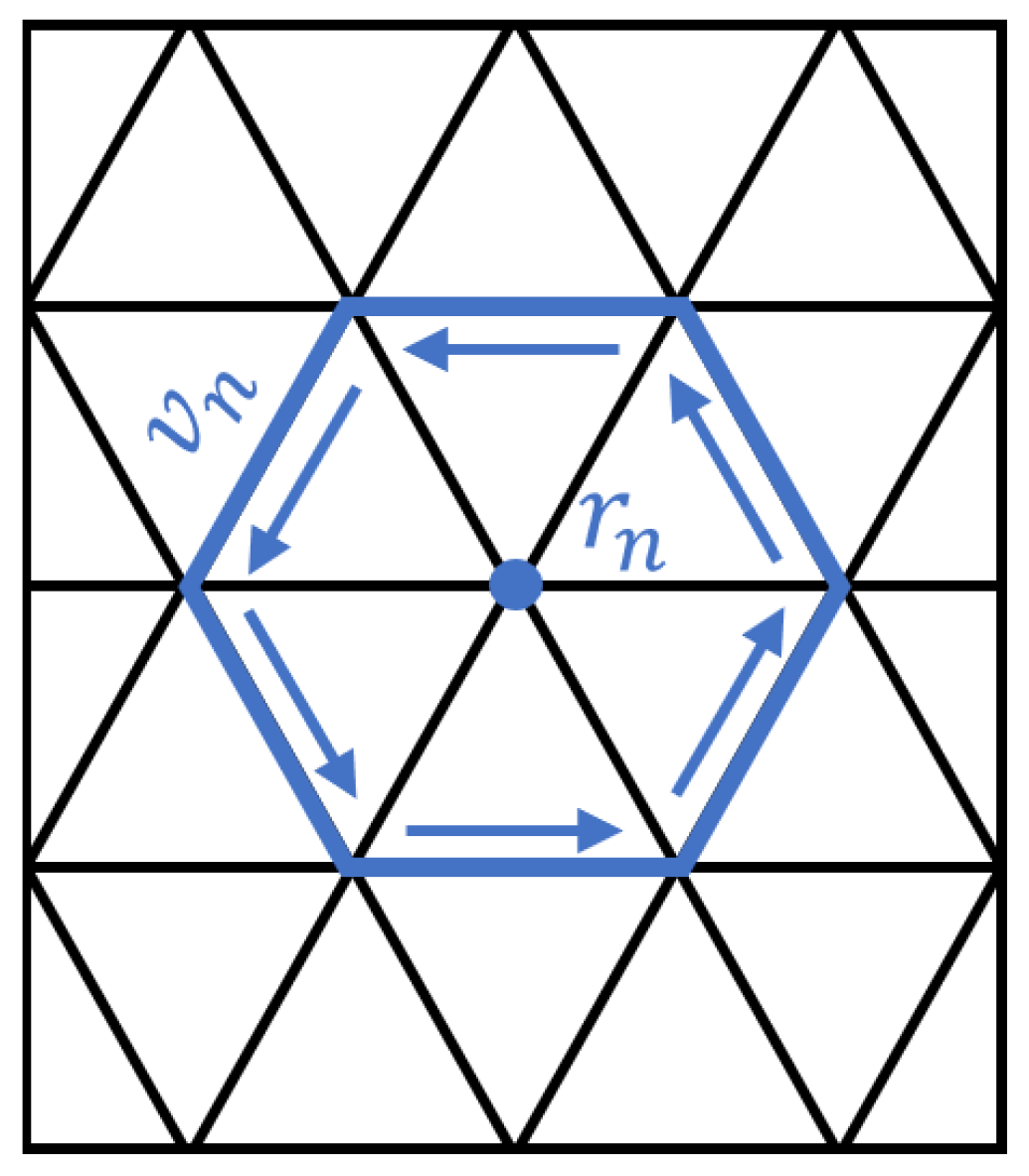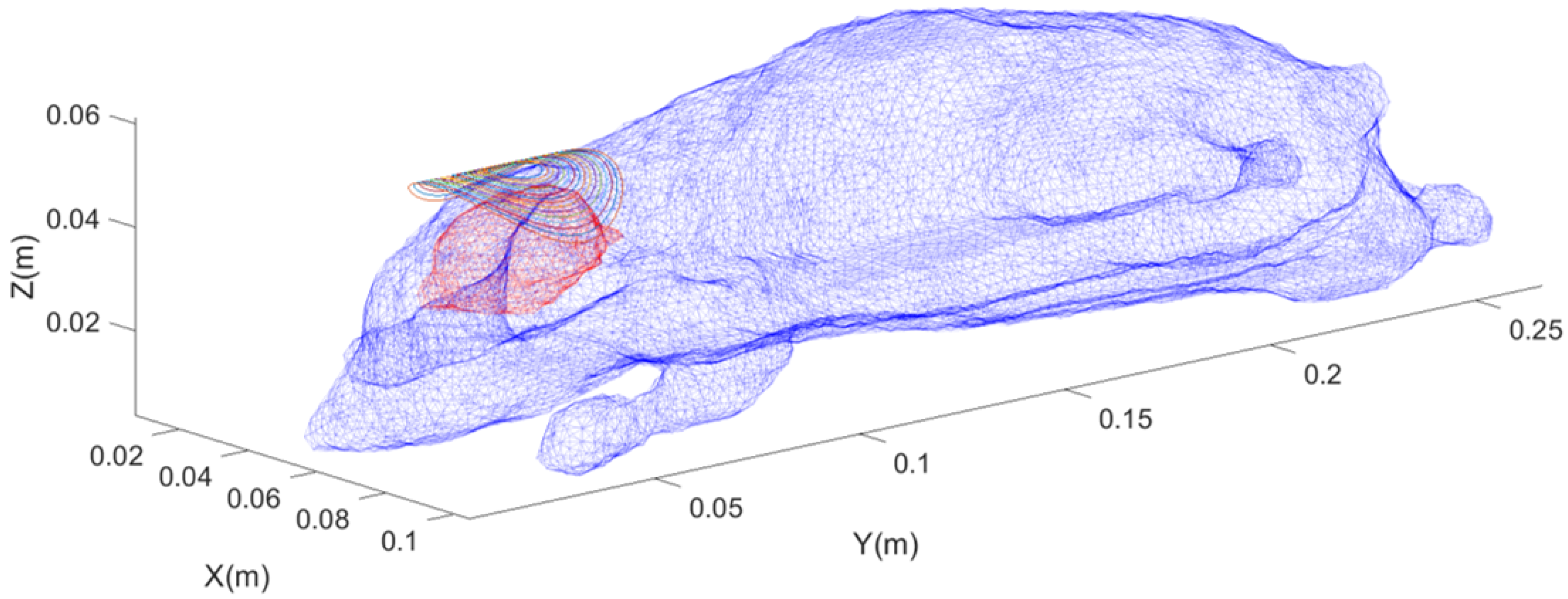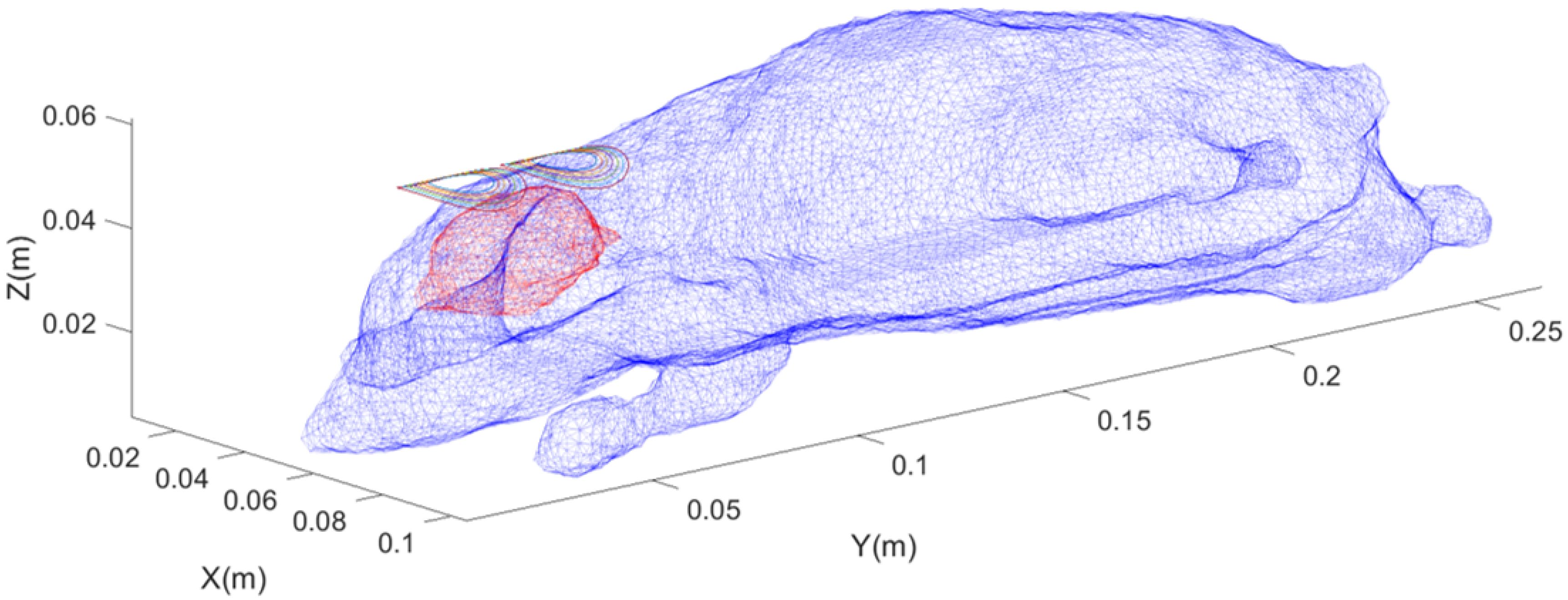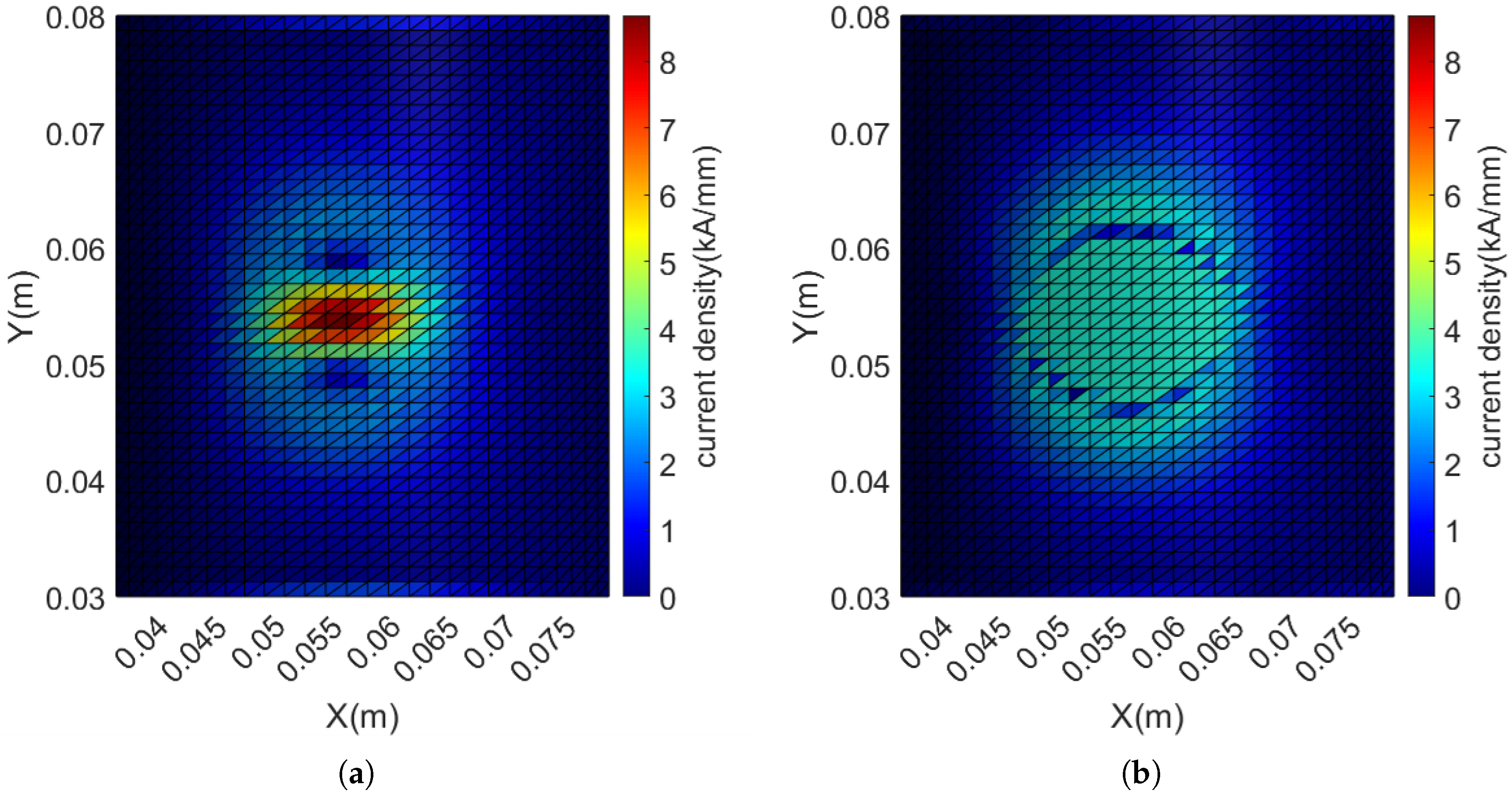Design of a Rat Transcranial Magnetic Stimulation Coil Based on the Inverse Boundary Element Method
Abstract
1. Introduction
- Limited space leads to difficulties in coil winding;
- The stimulation area of the coil is large, and the focusing ability is insufficient;
- The coil is difficult to use in actual experiments.
2. Design Theory
2.1. Inverse Boundary Element Method Based on Stream Function
- The streamlines (where C is a constant) are parallel to the current density vector of the current surface;
- The sequential arrangement of equipotential lines according to a certain interval represents the winding pattern of the coil, and the current along the streamlines is constant.
2.2. Constrained Design
3. Design and Simulation Outcomes
3.1. Arc-Shaped Circular TMS Coil
3.2. Arc-Shaped Figure-Eight TMS Coil
3.3. TMS Coil Designed by Inverse Boundary Element Method
3.4. Simulation Results of the Arc-Shaped Circular TMS Coil
3.5. Simulation Results of the Arc-Shaped Figure-Eight TMS Coil
3.6. Simulation Results of the TMS Coil Designed by the Inverse Boundary Element Method
3.7. Adding Current Density Constraints
3.8. Coil Winding
4. Conclusions and Discussion
Author Contributions
Funding
Data Availability Statement
Conflicts of Interest
References
- Cortes, R.A.; Holzman, D.D.; Green, A.E. Neuromodulation to Enhance Creative Cognition: A Review of New and Emerging Approaches. J. Cogn. Enhanc. 2023, 7, 18. [Google Scholar] [CrossRef]
- Barker, A.T.; Jalinous, R.I.; Freeston, I.L. Non-invasive magnetic stimulation of human motor cortex. Lancet 1985, 325, 1106–1107. [Google Scholar] [CrossRef]
- O’Reardon, J.; Solvason, H.; Janicak, P.; Sampson, S.; Isenberg, K.; Nahas, Z.; Mcdonald, W.W.; Avery, D.; Fitzgerald, P.; Loo, C. Efficacy and Safety of Transcranial Magnetic Stimulation in the Acute Treatment of Major Depression: A Multisite Randomized Controlled Trial. Biol. Psychiatry 2007, 62, 1208–1216. [Google Scholar] [CrossRef] [PubMed]
- George, M.S.; Lisanby, S.H.; Avery, D.; McDonald, W.M.; Durkalski, V.; Pavlicova, M.; Anderson, B.; Nahas, Z.; Bulow, P.; Zarkowski, P.; et al. Daily left prefrontal transcranial magnetic stimulation therapy for major depressive disorder: A sham-controlled randomized trial. Arch. Gen. Psychiatry 2010, 67, 507–516. [Google Scholar] [CrossRef] [PubMed]
- Carmi, L.; Tendler, A.; Bystritsky, A.; Hollander, E.; Blumberger, D.M.; Daskalakis, Z.; Ward, H.; Lapidus, K.; Goodman, W.; Casuto, L.; et al. Efficacy and Safety of Deep Transcranial Magnetic Stimulation for Obsessive-Compulsive Disorder: A Prospective Multicenter Randomized Double-Blind Placebo-Controlled Trial. Am. J. Psychiatry 2019, 176, 931–938. [Google Scholar] [CrossRef] [PubMed]
- Zangen, A.; Moshe, H.; Martinez, D.; Barnea-Ygael, N.; Vapnik, T.; Bystritsky, A.; Duffy, W.; Toder, D.; Casuto, L.; Grosz, M.L.; et al. Repetitive transcranial magnetic stimulation for smoking cessation: A pivotal multicenter double-blind randomized controlled trial. World Psychiatry 2021, 20, 397–404. [Google Scholar] [CrossRef]
- George, M.S.; Lisanby, S.H.; Sackeim, H.A. Transcranial magnetic stimulation: Applications in neuropsychiatry. Arch. Gen. Psychiatry 1999, 56, 300–311. [Google Scholar] [CrossRef]
- Strafella, A.P.; Paus, T. Modulation of cortical excitability during the implicit learning of a sensorimotor task. Neuroreport 2000, 11, 3555–3559. [Google Scholar]
- Uzair, M.; Abualait, T.; Arshad, M.; Yoo, W.K.; Mir, A.; Bunyan, R.F.; Bashir, S. Transcranial magnetic stimulation in animal models of neurodegeneration. Neural Regen. Res. 2022, 17, 251–265. [Google Scholar] [CrossRef]
- Boonzaier, J.; Petrov, P.I.; Otte, W.M.; Smirnov, N.; Neggers, S.F.W.; Dijkhuizen, R.M. Design and Evaluation of a Rodent-Specific Transcranial Magnetic Stimulation Coil: An In Silico and In Vivo Validation Study. Neuromodulation 2020, 23, 324–334. [Google Scholar] [CrossRef]
- Neziri, S.; Köseoğlu, A.E.; Deniz Köseoğlu, G.; Özgültekin, B.; Özgentürk, N. Animal models in neuroscience with alternative approaches: Evolutionary, biomedical, and ethical perspectives. Anim. Models Exp. Med. 2024, 7, 868–880. [Google Scholar] [CrossRef]
- Rinwa, P.; Eriksson, M.; Cotgreave, I.; Bäckberg, M. 3R-Refinement principles: Elevating rodent well-being and research quality. Lab. Anim. Res. 2024, 40, 11. [Google Scholar] [CrossRef] [PubMed]
- Beauchamp, A.; Yee, Y.; Darwin, B.C.; Raznahan, A.; Mars, R.B.; Lerch, J.P. Whole-brain comparison of rodent and human brains using spatial transcriptomics. eLife 2022, 11, e79418. [Google Scholar] [CrossRef]
- Wong, H.H.W.; Chou, C.Y.C.; Watt, A.J.; Sjöström, P.J. Neural Circuits: Comparing mouse and human brains. eLife 2023, 12, e90017. [Google Scholar] [CrossRef] [PubMed]
- Rotenberg, A.; Muller, P.A.; Vahabzadeh-Hagh, A.M.; Navarro, X.; López-Vales, R.; Pascual-Leone, A.; Jensen, F. Lateralization of forelimb motor evoked potentials by transcranial magnetic stimulation in rats. Clin. Neurophysiol. 2010, 121, 104–108. [Google Scholar] [CrossRef]
- Rastogi, P.; Hadimani, R.L.; Jiles, D.C. Investigation of Coil Designs for Transcranial Magnetic Stimulation on Mice. IEEE Trans. Magn. 2016, 52, 5200404. [Google Scholar] [CrossRef]
- Gasca, F.; Richter, L.; Schweikard, A. Simulation of a conductive shield plate for the focalization of transcranial magnetic stimulation in the rat. In Proceedings of the 2010 Annual International Conference of the IEEE Engineering in Medicine and Biology, Buenos Aires, Argentina, 31 August–4 September 2010; pp. 1593–1596. [Google Scholar]
- March, S.D.; Stark, S.J.; Hadimani, R.L.; Stiner, D.R.; Senter, M.J.; Spoth, K.K.; Crowther, L.J.; Jiles, D.C. Thermal and Mechanical Analysis of Novel Transcranial Magnetic Stimulation Coil for Mice. IEEE Trans. Magn. 2014, 50, 5100805. [Google Scholar] [CrossRef]
- Tang, A.D.; Lowe, A.S.; Garrett, A.R.; Woodward, R.; Bennett, W.; Canty, A.J.; Garry, M.I.; Hinder, M.R.; Summers, J.J.; Gersner, R.; et al. Construction and evaluation of rodent-specific TMS coils. Front. Neural Circuits 2016, 10, 47. [Google Scholar] [CrossRef]
- Parthoens, J.; Verhaeghe, J.; Servaes, S.; Miranda, A.; Stroobants, S.; Staelens, S. Performance Characterization of an actively cooled repetitive transcranial magnetic stimulation coil for the rat. Neuromodulation 2016, 19, 459–468. [Google Scholar] [CrossRef] [PubMed]
- Jayaprakash, S.; Priyam, R.; Prabhu, G.N.; Hadimani, R.L.; Mani, M. Transcranial Magnetic Stimulation: Design of a Stimulator and a Focused Coil for the Application of Small Animals. IEEE Trans. Magn. 2018, 54, 5200405. [Google Scholar] [CrossRef]
- Meng, Q.; Jing, L.; Badjo, J.P.; Du, X.; Hong, E.; Yang, Y.; Lu, H.; Choa, F.S. A novel transcranial magnetic stimulator for focal stimulation of rodent brain. Brain Stimul. 2018, 11, 663–665. [Google Scholar] [CrossRef]
- Odutola, T.; Myrovali, E.; Makridis, A.; Maniotis, N.; Angelakeris, M.; Kimiskidis, V.; Samaras, T. Can magnetic nanoparticles thermally assist the beneficiary role of transcranial magnetic stimulation? In Proceedings of the 2018 EMF-Med 1st World Conference on Biomedical Applications of Electromagnetic Fields (EMF-Med), Split, Croatia, 10–13 September 2018; pp. 1–2. [Google Scholar]
- Koponen, L.M.; Nieminen, J.O.; Ilmoniemi, R.J. Minimum-energy coils for transcranial magnetic stimulation: Application to focal stimulation. Brain Stimul. 2015, 8, 124–134. [Google Scholar] [CrossRef]
- Koponen, L.M.; Nieminen, J.O.; Mutanen, T.P.; Stenroos, M.; Ilmoniemi, R.J. Coil optimisation for transcranial magnetic stimulation in realistic head geometry. Brain Stimul. 2017, 10, 795–805. [Google Scholar] [CrossRef]
- Koponen, L.M.; Nieminen, J.O.; Ilmoniemi, R.J. Multi-locus transcranial magnetic stimulation—Theory and implementation. Brain Stimul. 2018, 11, 849–855. [Google Scholar] [CrossRef]
- Sánchez, C.C.; Garcia-Pacheco, F.J.; Rodriguez, J.M.; Hill, J.R. An inverse boundary element method computational framework for designing optimal TMS coils. Eng. Anal. Bound. Elem. 2018, 88, 156–169. [Google Scholar] [CrossRef]
- Cobos Sánchez, C.; Jurado García, J.J.; Ruiz Cabello, M.; Fernández Pantoja, M. Design of coils for lateralized TMS on mice. J. Neural Eng. 2020, 17, 036007. [Google Scholar] [CrossRef] [PubMed]
- Zhang, S.; Xie, X.; Xu, Y.; Mi, J.; Li, Z.; Guo, Z.; Xu, G. Effects of transcranial magneto-acoustic stimulation on cognitive function and neural signal transmission in the hippocampal CA1 region of mice. Neuroscience 2024, 556, 86–95. [Google Scholar] [CrossRef] [PubMed]
- Rissanen, I.J.; Souza, V.H.; Nieminen, J.O.; Koponen, L.M.; Ilmoniemi, R.J. Advanced Pipeline for Designing Multi-Locus TMS Coils With Current Density Constraints. IEEE Trans. Biomed. Eng. 2023, 70, 2025–2034. [Google Scholar] [CrossRef]
- Gondzio, J. Interior point methods in the year 2025. EURO J. Comput. Optim. 2025, 13, 100105. [Google Scholar] [CrossRef]
- Dogdas, B.; Stout, D.; Chatziioannou, A.F.; Leahy, R.M. Digimouse: A 3D whole body mouse atlas from CT and cryosection data. Phys. Med. Biol. 2007, 52, 577–587. [Google Scholar] [CrossRef]













| Coil Type | Stimulation Current Amplitude (kA) | Current Frequency (kHz) | Maximum Electric Field Strength (V/m) | Half-Value Volume (cm3) |
|---|---|---|---|---|
| Arc-shaped Circular TMS Coil | 6 | 1 | 103.58 | 1.78 |
| Arc-Shaped Figure-Eight TMS Coil | 5 | 2 | 100.85 | 0.84 |
| The coil designed using the IBEM | 6 | 2 | 98.26 | 0.36 |
| The coil designed by the IBEM with current density constraints | 6 | 2 | 91.80 | 0.40 |
Disclaimer/Publisher’s Note: The statements, opinions and data contained in all publications are solely those of the individual author(s) and contributor(s) and not of MDPI and/or the editor(s). MDPI and/or the editor(s) disclaim responsibility for any injury to people or property resulting from any ideas, methods, instructions or products referred to in the content. |
© 2025 by the authors. Licensee MDPI, Basel, Switzerland. This article is an open access article distributed under the terms and conditions of the Creative Commons Attribution (CC BY) license (https://creativecommons.org/licenses/by/4.0/).
Share and Cite
Zhao, C.; Xu, Y.; Jiao, L.; Hu, L.; Lv, H.; Yang, P. Design of a Rat Transcranial Magnetic Stimulation Coil Based on the Inverse Boundary Element Method. Magnetism 2025, 5, 28. https://doi.org/10.3390/magnetism5040028
Zhao C, Xu Y, Jiao L, Hu L, Lv H, Yang P. Design of a Rat Transcranial Magnetic Stimulation Coil Based on the Inverse Boundary Element Method. Magnetism. 2025; 5(4):28. https://doi.org/10.3390/magnetism5040028
Chicago/Turabian StyleZhao, Chenyu, Yun Xu, Lixin Jiao, Linhai Hu, Haoran Lv, and Peng Yang. 2025. "Design of a Rat Transcranial Magnetic Stimulation Coil Based on the Inverse Boundary Element Method" Magnetism 5, no. 4: 28. https://doi.org/10.3390/magnetism5040028
APA StyleZhao, C., Xu, Y., Jiao, L., Hu, L., Lv, H., & Yang, P. (2025). Design of a Rat Transcranial Magnetic Stimulation Coil Based on the Inverse Boundary Element Method. Magnetism, 5(4), 28. https://doi.org/10.3390/magnetism5040028






